|
|
Post by wbill76 on Jun 12, 2018 13:42:23 GMT -5
I've always wanted to do a WWI tank project but what always held me back was the relatively poor quality/age of the kits that were out there. That all changed when the 100th anniversary dates started rolling around and the kit manufacturers started pumping out modern-quality stuff. Previously I'd built Meng's 1/35 FT-17 but what I really wanted to tackle was the German's A7V monster. Now that summer break has arrived for the year, I've got the chance to do just that. I'm not planning anything extravagant beyond what's already in the box except for some Aber upgrades for the armament. It's hard to believe that it's been more than 2 years since I last built an armor subject, so it's fitting that it should be this one I think!  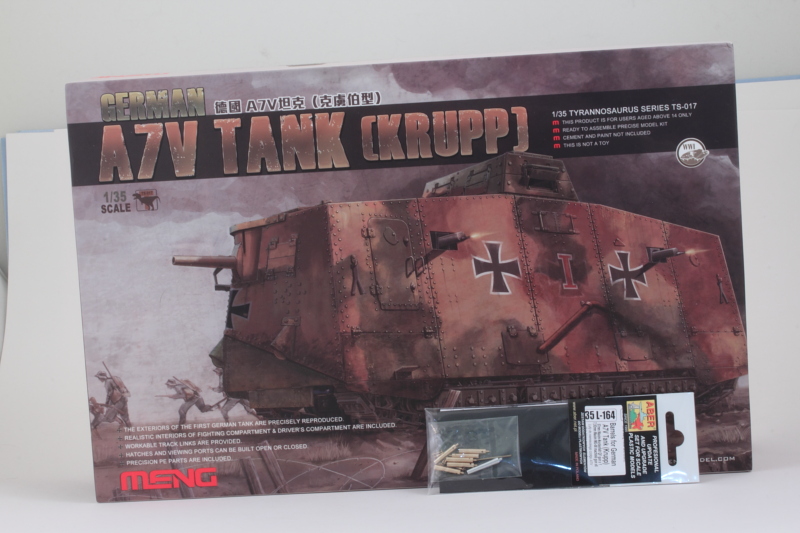 |
|
|
|
Post by Tobi on Jun 12, 2018 14:17:03 GMT -5
During the last two months I had this kit in my hands several times, but always put it back to the stash again.
Will be watching with interest!
|
|
|
|
Post by wbill76 on Jun 12, 2018 16:35:47 GMT -5
During the last two months I had this kit in my hands several times, but always put it back to the stash again. Will be watching with interest! It's definitely an unusual subject...big and boxy!  Glad to have you along for the ride Tobi. |
|
|
|
Post by wbill76 on Jun 12, 2018 16:43:18 GMT -5
It seems that the German obsession with a ton of road wheels in their armor designs was present from the very beginning! The first 2 steps in the instructions deal with assembling the three roadwheel sets per side that make up the running gear. Each road wheel has two halves to assemble and there are two different wheel types that alternate with each other, so you have to keep those straight in the assembly process. Each set installs to a different suspension module (A17, A16, A15), so I labeled the module with its corresponding part number so I could avoid confusing them. Getting all three modules together with the road wheel assemblies requires no less than 75 parts, so a lot involved to get to this first progress shot!  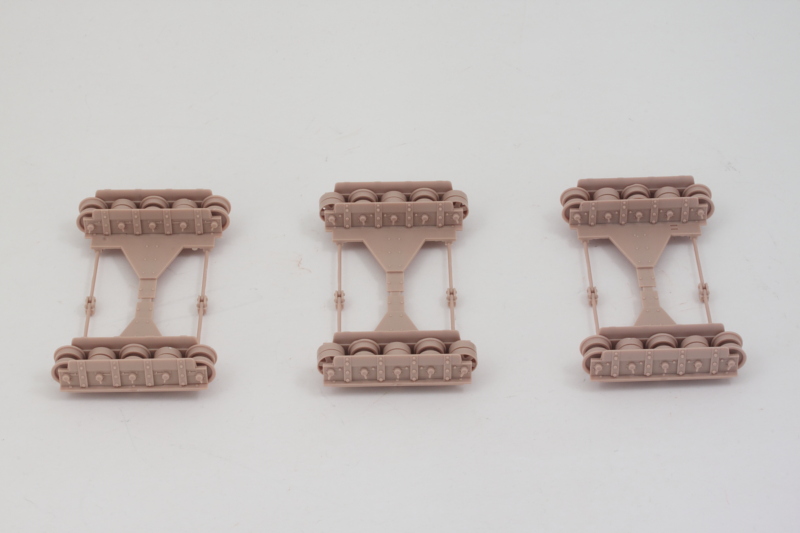 |
|
|
|
Post by Leon on Jun 12, 2018 18:51:36 GMT -5
Glad to see you back at the bench Bill!  Looks like your off to a good start.I'll be following along.  |
|
|
|
Post by wbill76 on Jun 13, 2018 7:58:17 GMT -5
Glad to see you back at the bench Bill!  Looks like your off to a good start.I'll be following along.  Thanks Leon! I have to pace myself, I've lost my tolerance for glue fumes it's been so long!  |
|
|
|
Post by Tojo72 on Jun 13, 2018 20:26:39 GMT -5
Ahh,schools out and Bill is at the bench.Really looking to follow you on this one.
|
|
|
|
Post by wbill76 on Jun 13, 2018 20:54:11 GMT -5
Thanks Anthony! It's almost a case of reverse-hibernation when it comes to time of year and available bench time.  |
|
|
|
Post by wbill76 on Jun 18, 2018 17:13:19 GMT -5
Work continued on the Step 1-2 double-combo related to the running gear with the latest focus on getting the sprockets, idlers, and other details squared away. The idlers assemble in a 'handed' fashion so you have to be careful to assemble them to reflect that. There's no glue involved in assembling them, only snap-fit, so if you make a mistake it's easy to fix. The sprockets don't require the same care as they are identical in their assembly. I added the spring details to the three suspension modules as called for to round things out. 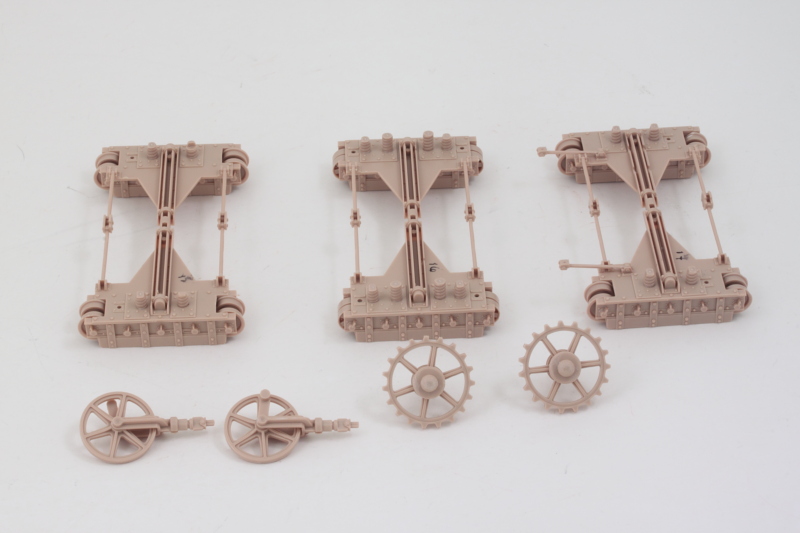 Step 3 assembles the transmission and includes the use of poly-caps trapped inside the side portions to allow the drive sprockets to remain movable later on. Some slight sanding around the join surfaces is all that's needed to create a unified look. 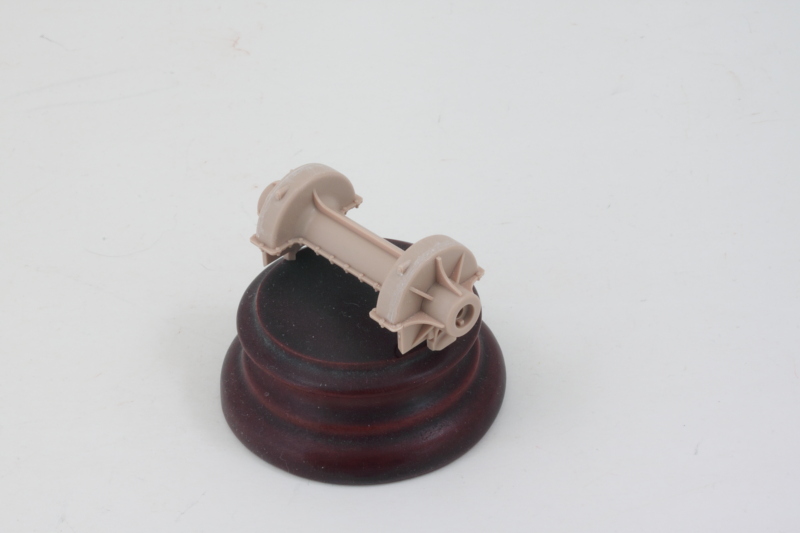 Step 4 is a big step as it assembles the lower hull pan and is a little tricky to get it all together and square. After fiddling with different test fits, I found the best way was to install the nose plate, B3, first since it attaches to the front of the transmission area and provides a solid point to work from. I added the side panel B1 and only applied glue to the support tabs for it to kind of tack it in place. I dry fit the rear plate, B2 in position and then added the other side panel, B18. Only after both side plates were in place did I add liquid glue to the rear plate joins and along the full length of the sides. A couple of sliding clamps helped hold it all together while the glue set up and voila! The lower hull was together. 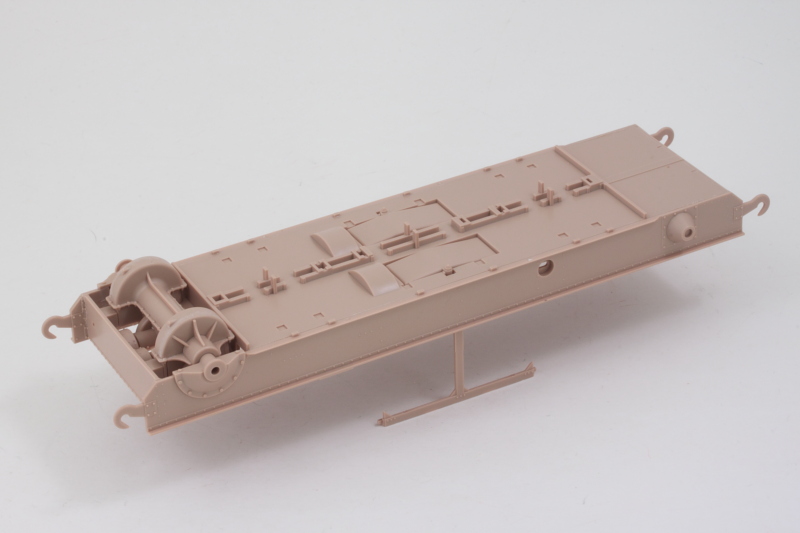 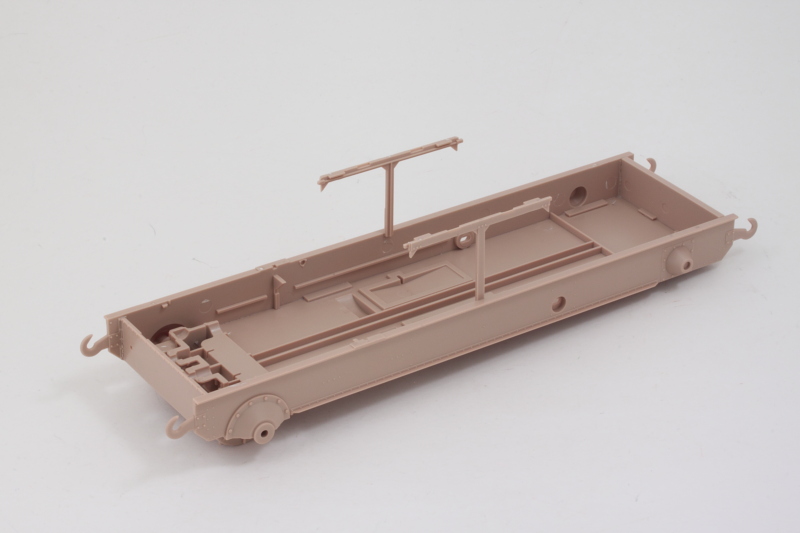 Next up will be adding the support rails and return roller racks which is another multi-part adventure!  |
|
|
|
Post by Leon on Jun 18, 2018 18:24:54 GMT -5
Your making good progress Bill!  |
|
|
|
Post by wbill76 on Jun 18, 2018 19:23:04 GMT -5
Your making good progress Bill!  Thanks Leon, so far, so good!  |
|
|
|
Post by dierk on Jun 19, 2018 5:03:54 GMT -5
Looking good!
Some interesting WWI subjects around - but I'm not going to branch out into that field, happy watching what you do, though.
|
|
|
|
Post by wbill76 on Jun 19, 2018 10:01:29 GMT -5
Looking good! Some interesting WWI subjects around - but I'm not going to branch out into that field, happy watching what you do, though. Good to have you along Dierk, can definitely understand avoiding branching into this area although there are a lot of early inter-war Soviet designs available now that I never thought would ever see the light of day in kit form...so be warned!  |
|
|
|
Post by dierk on Jun 19, 2018 10:04:50 GMT -5
Looking good! Some interesting WWI subjects around - but I'm not going to branch out into that field, happy watching what you do, though. Good to have you along Dierk, can definitely understand avoiding branching into this area although there are a lot of early inter-war Soviet designs available now that I never thought would ever see the light of day in kit form...so be warned!  I know, there's some rather weird and wonderful resin stuff distributed/made by Yellow House Club in Russia. Sorry, just got to wipe away the puddle of drool... |
|
|
|
Post by wbill76 on Jun 19, 2018 18:44:31 GMT -5
Work continued today on the lower hull and suspension components. The instructions have a separate step, Step 5, that shows the two types of return roller racks that are needed and how to assemble them. They have a very narrow contact surface where the two halves meet up so I elected to install them directly as individual parts to the lower hull as called for in Step 6 versus trying to assemble them as pairs first and then attach them. It seemed to go easier since there are small mount tabs that they need to attach to on the lower hull and the notches in the parts don't always 100% align with them. I used liquid glue and tweezers to work with the halves one set at a time until I had all 6 attached. 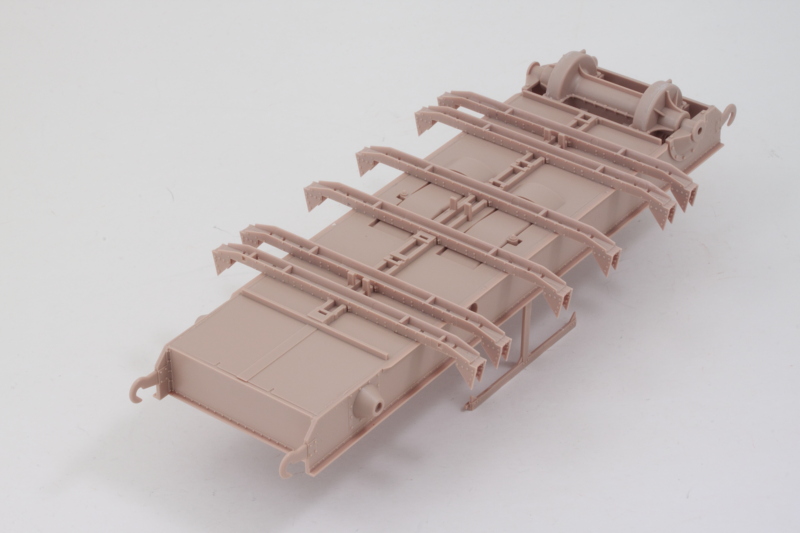 Step 7 deals with the return rollers along with the side mufflers and some bracing for the lower hull. The return roller racks also have two different styles, one for the middle set and another for the front and rear sets. The middle set can be assembled as indicated in the instructions since the bottom edges meet but the other sets have no contact points beyond the friction fit of the two halves inside the return rollers. This means that their only glue points are where the install on the racks, so I had to be very careful in fitting them in place with tweezers and then applying liquid glue once they were set with a small pointed brush to glue them down. The idlers were installed as well and the sprockets inserted into the poly-cap mounts so that they would stay movable. The mufflers were assembled and carefully sanded to remove their join lines before being added in place on the hull. There was a little bit of play in their mount points, so a little care was necessary to ensure they lined up properly relative to the return rollers to avoid problems with the tracks later on. 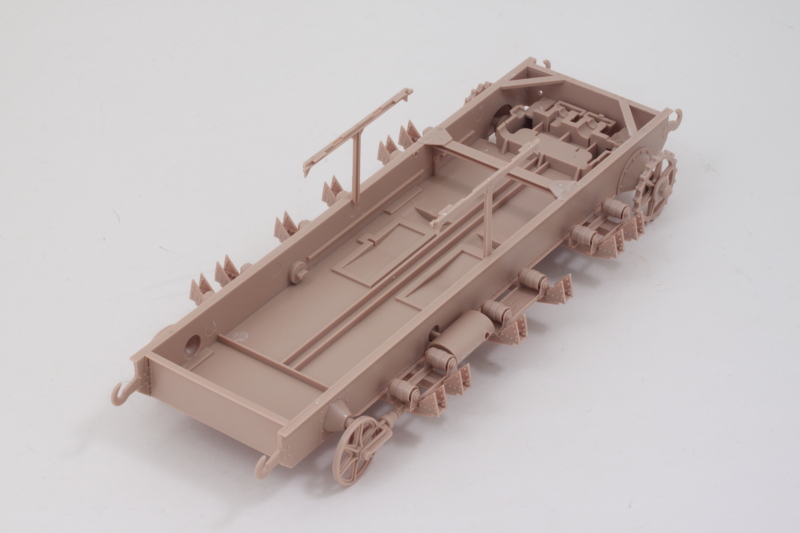 Step 8 is the big moment of truth as it installs the three road wheel assemblies from earlier in place on the hull. I started with the end set with the sprockets and used regular glue on the contact points to ensure it grabbed quickly and held in case small adjustments were needed. You do have to be a little careful in adding the other two modules as they are subtly designed to install only one way to ensure all three line up correctly in the end. 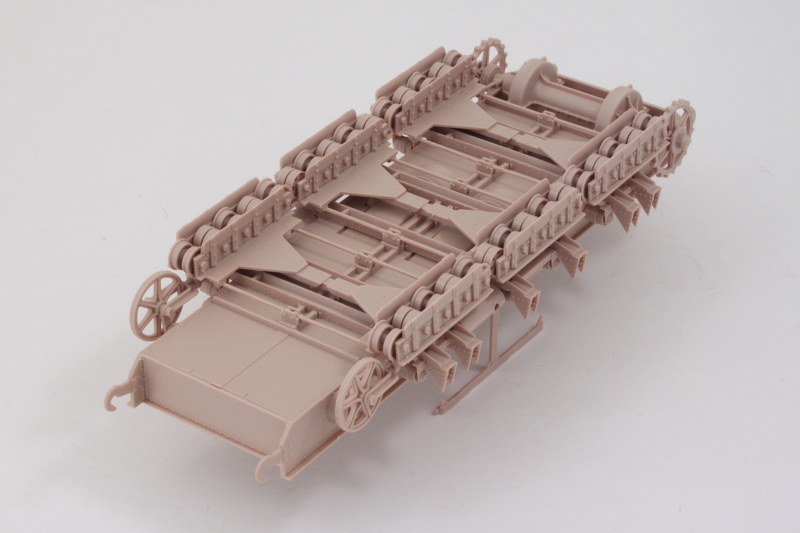 Rounding out the day's efforts, I added the small linkage rods that are called for in Step 9 and the big girl is now up on her feet. 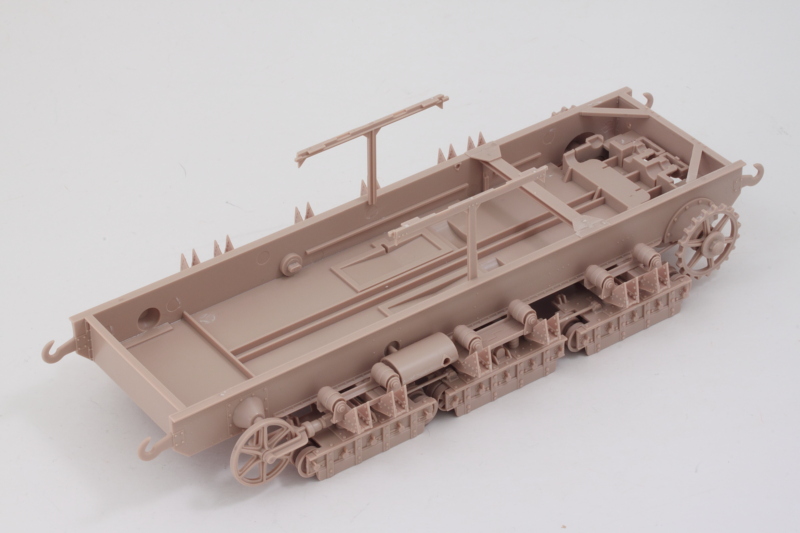 Next up will be tackling the track assembly. There are 48 links called for per side and each one is assembled out of 2 parts, so that will probably eat up a full day or two depending. |
|
|
|
Post by dierk on Jun 20, 2018 3:22:55 GMT -5
Wheelie nice work, Bill! I know...just getting my hat and coat, and I'll be out of here.
What is it with German armour and tons of wheels?
|
|
|
|
Post by wbill76 on Jun 20, 2018 10:36:21 GMT -5
Wheelie nice work, Bill! I know...just getting my hat and coat, and I'll be out of here. What is it with German armour and tons of wheels? That curse has always been there from the beginning it seems!  In the case of the A7V, they used existing Holt tractor designs and just bolted on what they needed to support the chassis design and voila! Tons of road wheels.  |
|
|
|
Post by 406 Silverado on Jun 20, 2018 17:19:51 GMT -5
Nice clean building as usual. Good to see you back at the bench my friend. You should be able to get a few builds done by the time school starts up again.
|
|
|
|
Post by wbill76 on Jun 20, 2018 17:26:44 GMT -5
Nice clean building as usual. Good to see you back at the bench my friend. You should be able to get a few builds done by the time school starts up again. Feels good to bring the bench out of the year-long storage situation for sure! Don't know how many I can get done in the available time but since I don't have any big ships planned, it should be more than 1!  |
|
|
|
Post by Leon on Jun 20, 2018 18:06:00 GMT -5
Really making good progress Bill!  That sure is a lot of parts for the lower hull.  |
|
|
|
Post by wbill76 on Jun 21, 2018 10:04:54 GMT -5
Really making good progress Bill!  That sure is a lot of parts for the lower hull.  No kidding! Especially when you consider almost all of it gets hidden away after the tracks and side armor plates are added. Still have to do it all in order to support the vehicle though.  |
|
|
|
Post by wbill76 on Jun 21, 2018 16:21:34 GMT -5
Bench time for the last couple of days has been devoted off-and-on to getting the caterpillar-style tracks assembled. Each link has 2 parts, the bottom portion that contacts the ground and the upper part that contacts the road wheels, sprockets, etc. Meng designed these in a clever way, they only go together solidly one way but you do have to pay attention when assembling them to ensure you don't make a mistake in the repetition necessary to get all 48 links per side together. Fortunately, there are 16 spares available on the sprues if you do make a mistake. I used regular Testors glue to provide a little more grab and control in the link assembly process and worked on 7 links at a time since that's how they are molded on the sprues. Each part has a pair of contact points and careful removal from the sprues with pointed cutters meant that there was only a little bit of clean-up required before assembling the parts together. Once I had 7 links done, they were clipped together without glue so they could remain workable and then the next links added on in similar fashion until the full track run was created. 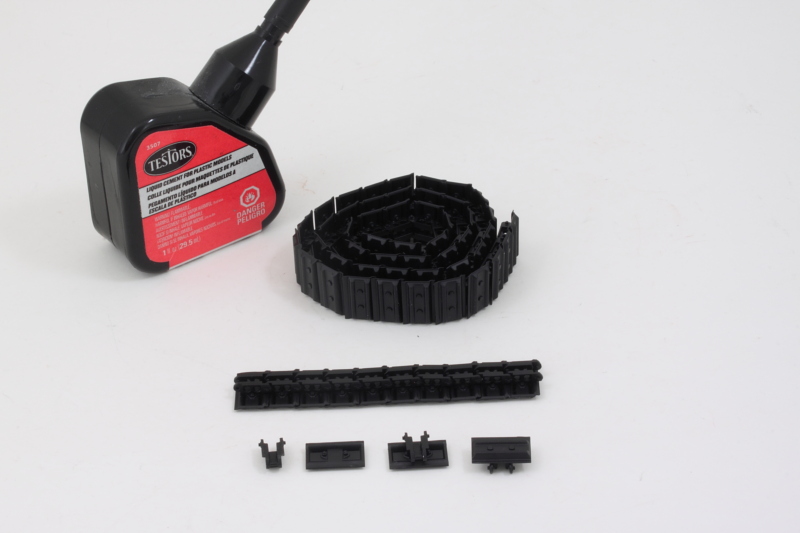 I did a check using some small strips of blue painter's tape with each track side to make sure the fit was solid for each run of 48 links. Since neither the idler or sprocket are adjustable, the only flexibility is in the track runs themselves once assembled and 48 links worked beautifully for both sides. The sprockets are fairly stiff due to the poly caps and I ended up turning them with a pair of tweezers to feed the track run through as needed for the test fit. 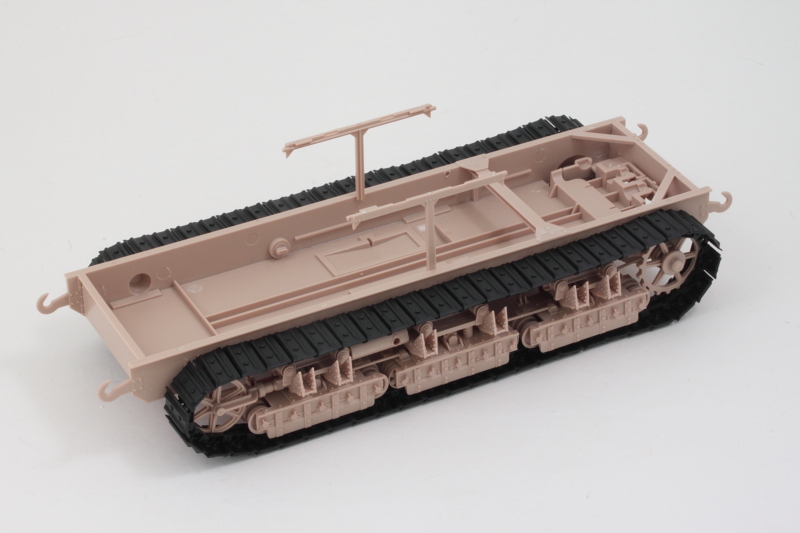 The next step in the instructions calls for the floor plates of the fighting compartment to be installed. These also overhang the tracks, so I will do a test to see how well they can or cannot be fed with the plates in place as that will decide when the first round of paint work needs to be done on the lower hull and tracks. |
|
|
|
Post by wbill76 on Jun 24, 2018 17:41:00 GMT -5
Not a huge update but an important one all the same. I did a test fit with the fighting compartment floor plates and it's possible to still feed the tracks through with them in place without difficulty, so I went ahead with Step 10 and installed the four plates in place. The fit of the four plates together is pretty snug, so it's important to ensure that the front and rear plates are positioned correctly before committing to glue on the smaller side plates. I used some Mr. Hobby Mr. Cement glue for this as it's a little thicker than regular liquid glue and allows more flexibility and applied some of the thinner liquid glue to the seams once everything was solidly in place. 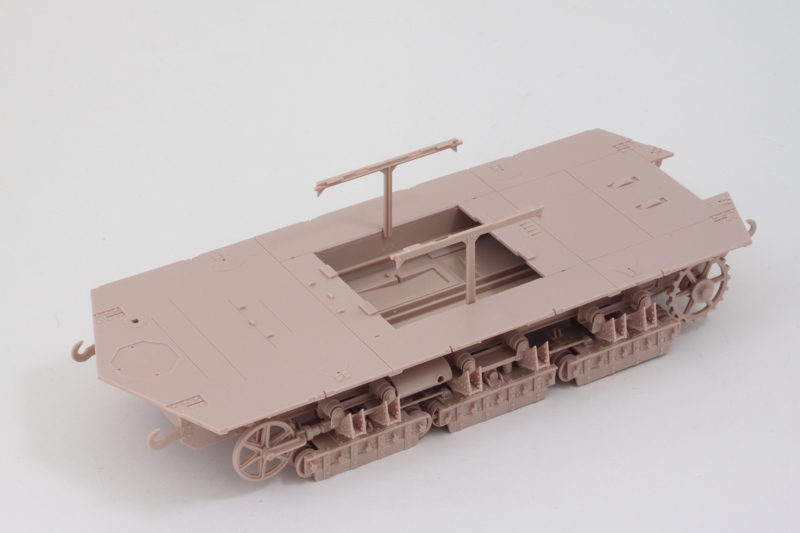 Moving on to Step 11, this assembles the driver's compartment and adds all the details to the floor plate there. It's a little tricky getting all of the control levers together since they are small to begin with and don't have very large contact surfaces with each other where they do touch. I found it easiest to add them into the floor first and then connect them up as needed. For the crew seats, I assembled their sides first and then added the support posts underneath. Once that was solid, the seats were installed on the floor. 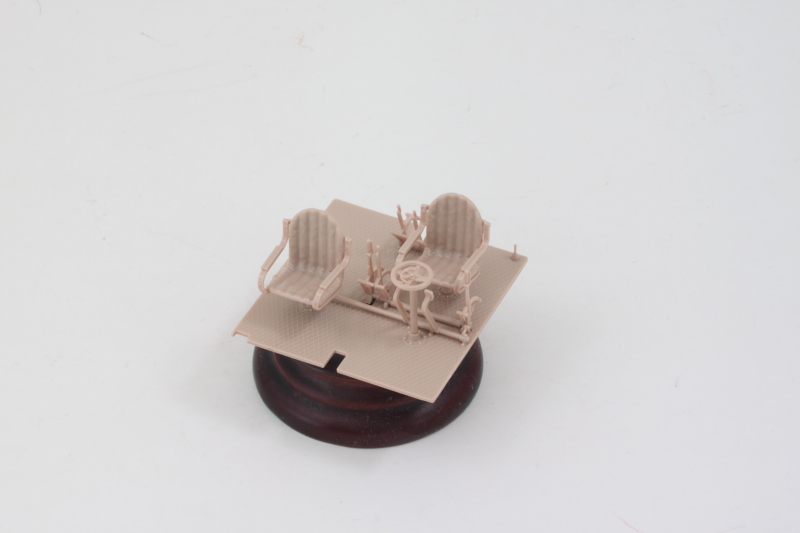 Step 12 is simple enough, it installs the now-complete driver's compartment into position on the support frames over the engine bay. I decided, after much deliberation, not to open up the doors or hatches to display the interior due to the complications involved in painting both inside and outside. That's not to say that it can't be done, I'm just choosing not to do it with this particular build. I'll still build up the interior as called for, especially since many of the components are necessary to support the hull box, but won't be detail-painting them. 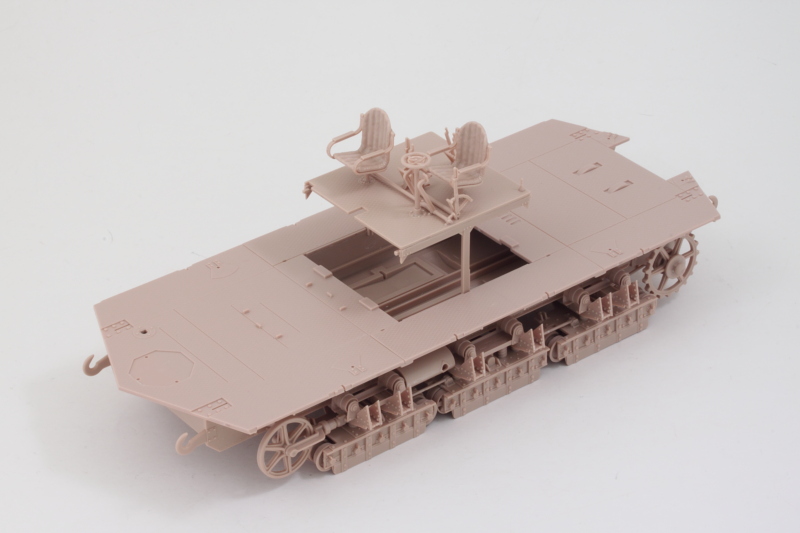 Next up are the radiators that install below the driver's compartment. |
|
|
|
Post by Leon on Jun 24, 2018 18:49:26 GMT -5
Nice progress Bill! Tracks and drivers compartment look good.
|
|
|
|
Post by wbill76 on Jun 24, 2018 18:57:17 GMT -5
Nice progress Bill! Tracks and drivers compartment look good. Thanks Leon! I would hate to be the one sitting in that compartment...the foot pedals look like you would have to be a contortionist to make them work and being right over both of those engines had to be a tortuous combination of loud and hot as a special bonus.  |
|
|
|
Post by Tojo72 on Jun 24, 2018 19:58:11 GMT -5
Looking good Bill,I dont know if you ever checked out Karl Logans build log on FSM from a few years ago- outstanding
|
|
|
|
Post by dierk on Jun 25, 2018 6:03:43 GMT -5
Nice progress Bill! Tracks and drivers compartment look good. Thanks Leon! I would hate to be the one sitting in that compartment...the foot pedals look like you would have to be a contortionist to make them work and being right over both of those engines had to be a tortuous combination of loud and hot as a special bonus.  Apparently the fumes were a real killer too - if you pardon the pun. Shame you're not painting the interior - in that case, why not just add the parts required to give the hull stability and put the rest in the spares box? |
|
|
|
Post by wbill76 on Jun 25, 2018 11:05:54 GMT -5
Looking good Bill,I dont know if you ever checked out Karl Logans build log on FSM from a few years ago- outstanding Thanks Anthony! Karl's build is one of the reasons I picked it up for the stash when it was released, just hadn't had the chance to get to it until now.  Dierk Dierk , you're on to something with the fumes. The hull roof has these giant slotted grates over both large compartments plus one just for the driver, so ventilation was clearly a necessity...or a comment on diet and sanitation, take your pick!  I'm toying with the idea of doing another one in the future as a cutaway, so I am using this as kind of a test drive first to see if I really want to... especially since there are versions available with the engines included. |
|
|
|
Post by wbill76 on Jun 25, 2018 19:01:36 GMT -5
Following on with the interior, next up was assembling the front and rear radiator modules. Step 13 details what is needed for them and has them split out as two separate assemblies, so I worked on one at a time to avoid accidentally mixing them up. The forward radiator has a larger step at the bottom to help tell them apart and ensures that you don't accidentally install it in the wrong position since it won't sit at the right height to mate up with the driver's compartment floor otherwise. 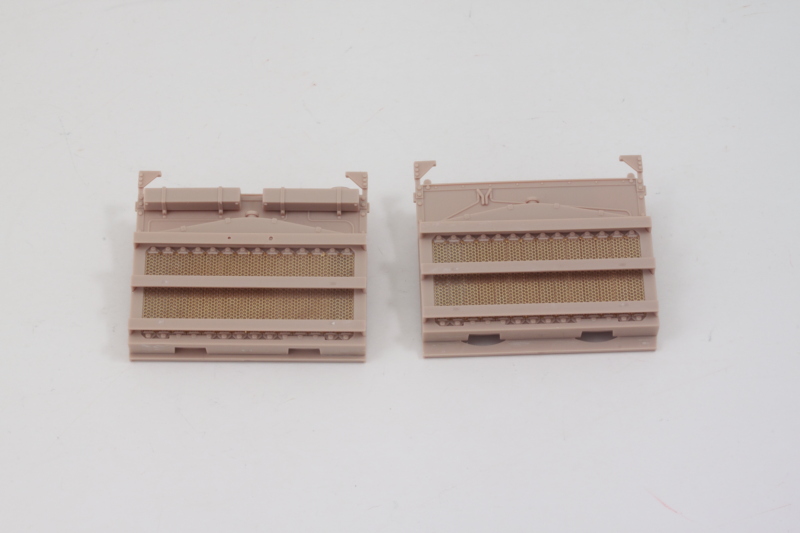 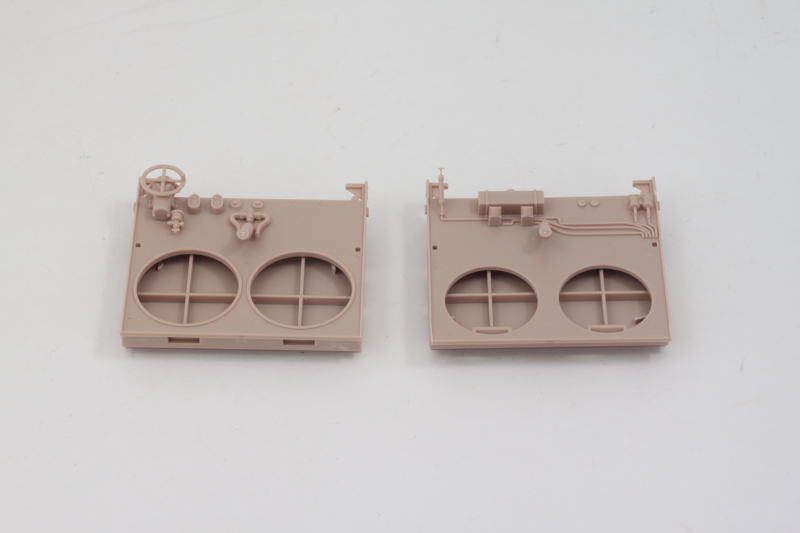 Once both modules were assembled, it was time to add them to the fighting compartment as called out in Step 14. The fit between the two modules, the driver's compartment floor, and the hull floor is pretty tight and it took some gentle pressure and coaxing to get it all to sit together square. Careful use of liquid glue at the connecting points after it was lined up ensured it would stay that way. 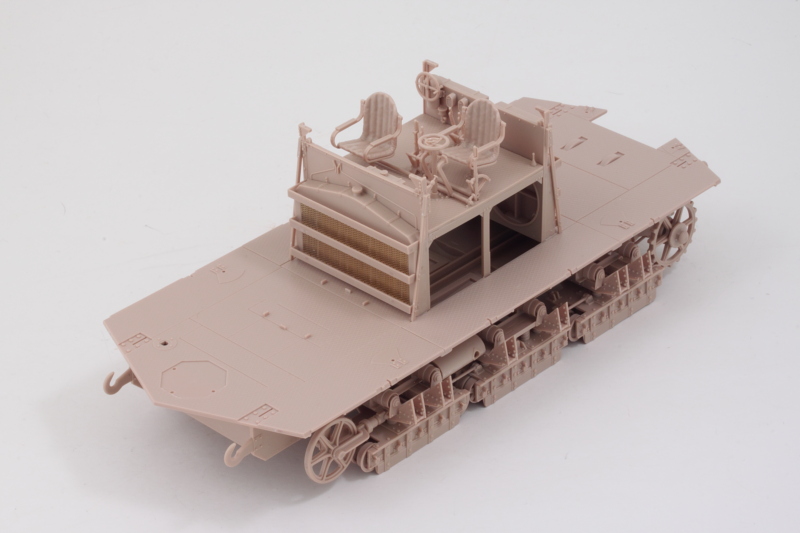 Next up is the QF 57mm main gun assembly. |
|
Foenetik
Full Member
   November '24 Showcased Model Awarded
November '24 Showcased Model Awarded
Member since: March 2014
Posts: 609 
|
Post by Foenetik on Jun 25, 2018 19:29:49 GMT -5
Nice build thus far. Looks like a nice kit
|
|